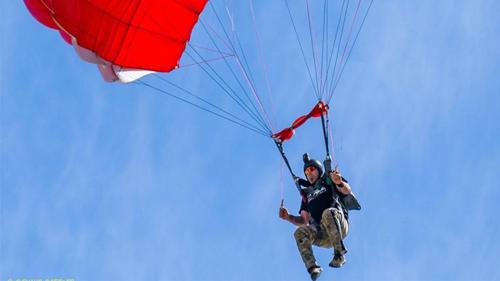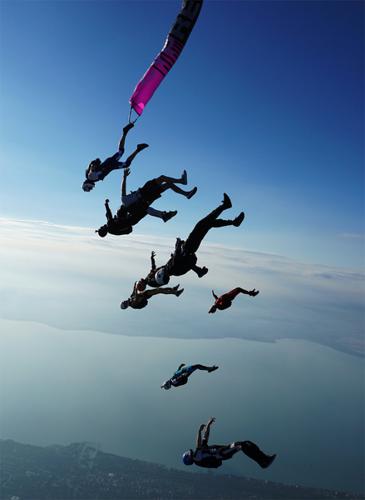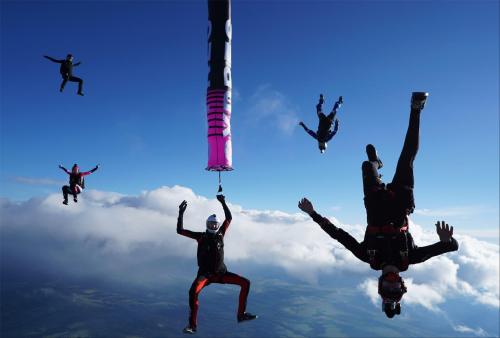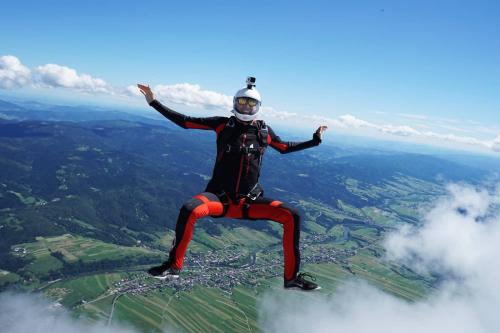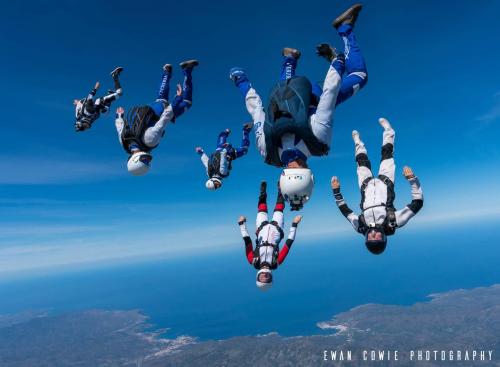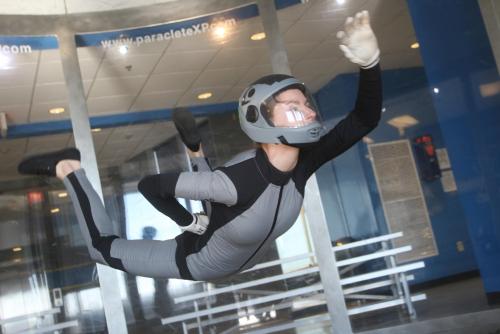Useful Training for BASE, Right There on the Dropzone
Courtesy Apex BASE: Pascal Constantineau flying his FLiK at Skydive Perris during his BASE canopy course with Dimitrije Dadic. (Of note: Square1 offers discounted rental rigs to people taking Dimitrije’s BASE canopy courses.)
If you’re like most people, your idea of dropzone training for the stresses of the BASE environment involves trying to look nonchalant when you climb into a hot-air balloon basket. If you have no access to such a thing (and/or if you’re significantly smarter than the average bear) you’re probably looking for more. You know you need a way to get as many jumps under your belt as possible with your BASE parachute proudly overhead--preferably, with a reserve on standby. But how?
“Skydiving your BASE canopy is by far the best way to learn canopy skills for BASE jumping before making a BASE jump,” says Steve Doherty, who served as Director of Operations of Apex BASE for five years. “In a perfect world, everyone would be able to jump their BASE canopy skydiving--a lot--before they ever took it out on a BASE jump.”
Ideally, if you’re serious about this, you’re not just swapping gear willy-nilly on every dropzone day. You have a dedicated skydiving system, configured for the purpose. Here’s how to build it.
The Canopy
“It's only with the introduction of ultralight canopies that jumping BASE canopies at the dropzone has become a possible and useful activity,” he continues. “Anything you can use in the BASE environment, you can use in the skydiving environment--of course, in the skydiving environment, you have to manage your opening speed.”
“If you take your whole BASE setup: mesh slider, BASE bridle and BASE pilot chute, you're going to have a very brisk skydiving opening,” he adds. “In our collective experience at Apex, we found that you can make two or three slider-up skydives on this kind of setup in a day and it's okay. If you were going to make five to ten, you need to start making modifications.”
As any seasoned BASE jumper will tell you, nothing flies quite like an actual BASE canopy--so the goal is to get as close to it as possible. Athletes who want to train BASE canopy skills should choose an ultralight canopy and seek a skydiving container that fits it.
That said: Athletes who want to get into flying a wingsuit with the intention of BASE jumping but don’t want to jump a BASE-sized canopy for all their wingsuit skydiving training now have some options.“On today’s market, you can find seven-cell, BASE-type canopies created for the skydiving environment. The benefit is that--while these canopies do have some of the distinctive BASE properties--you can jump all day and not feel it when you wake up the next morning.
The Risers
Forward-facing risers are more appropriate in the skydiving environment for a simple reason: the possibility of a horseshoe malfunction. During a horseshoe malfunction, forward-facing risers are the only type that you can reliably cut away.
“During a horseshoe malfunction with rear-facing risers,” Doherty notes, “Your body will be in the way of the twisting movement that the three-rings need to do in order to release. So, when you’re jumping a two-parachute system, we always recommend jumping forward-facing risers.”
The Container
As you’ve certainly noticed by now: Apart from student gear, most of the containers available for sport use won't fit BASE canopies. According to Apex, the best way around that is to jump an ultra-light parachute. (Take, for instance, the Lobo: a 250 can pack up to the size of a skydiving 180.)
“More and more drop zones are coming around to the idea of BASE jumping,” Doherty continues, “That is to say: Not assuming that it’s attracting bad publicity to the sport of skydiving. Nowadays, they're more willing to let their student gear be used. Here in Southern California, we suggest going to Square One. They have a huge selection of demo equipment, so it’s relatively easy to get the largest demo container they have and pack into it the largest BASE canopy that fits.”
Most drop zones have a container that's sized for a 180/200. The Apex team have, however, not been able to find a non-tandem or -military container able to fit anything bigger than a 300+ made from F-111 fabric. (UltraLite PN-9 is a different story, and large canopies are more easily accommodated.)
The D-Bag
Talk to your local CReW dogs: You don't have to use a deployment bag when you skydive.
“You can free-pack your BASE canopy into a properly-sized skydiving container, just like you do in your BASE container,” he says, “except the rectangle is a lot smaller, so you’ll have to stack it up.”
If that sounds a little unnerving, ask for help. Doherty notes that a lot of the older generations of CReW skydivers are quite familiar with that deployment method, so ask them for advice.
If you do use a D-bag, he insists that you’re using it correctly. Take note of what BASE canopy you're using. Not all BASE manufacturers use a metal ring at the top of the parachute. Some do use a metal ring, just like you'd find on a skydiving canopy. The Blackjack and Ace canopies built by Asylum also use a metal ring. Atair doesn't. And Apex doesn’t, either. To get this right, use a metal connect link to prevent the canopy from getting sucked up into the grommet of the bag. (Very importantly, the link needs to be inside the bag.)
The Pilot Chute
You are going to want to use a slightly larger pilot chute for a BASE canopy than you would if you were jumping a skydiving canopy, because the BASE canopy itself is much larger.
“You don't need to use the same-sized pilot chute that you use in the BASE environment,” Doherty notes, “We recommend a 32" non-collapsible pilot chute for skydiving. It's much larger than a sky pilot chute, which is typically 28 inches.”
The Bridle“We typically use a longer bridle in BASE jumping,” Doherty says. “You don't need to take the BASE bridle over to make the BASE canopy work. You'd want to use the bridle that was appropriate for whatever discipline you were doing in skydiving. We recommend using a normal skydiving bridle for normal skydiving freefalls. If you’re wingsuiting, we recommend using whatever bridle length you'd normally use for wingsuiting in the BASE environment.”
The Slider
You can use a mesh slider, but it’s not ideal.
“In BASE, we’re so close to the ground that we tolerate--even welcome--brisk openings,” Doherty says. “But if you make five jumps on a mesh slider at terminal, you’re going to feel it. You won’t regret using a sail slider in the skydiving environment. That said: If you’re making hop-and-pops, a mesh slider is not a problem.”
The Jumps
Once you’re all geared up, there’s only one place to go: Up. And when you get there, you’ll have a few more things to think about.
“When you're jumping a BASE canopy on the dropzone, you have to think about where you're going to be in the pattern,” Doherty advises. “You're jumping a parachute that's much larger than the other parachutes around you and you're going to descend a lot slower. Especially at large dropzones where they’re flying multiple aircraft and doing multiple load drops over the same area, this can get problematic. Stay out of the way.”
The Mentality
If you have access to a candy-colored, fire-powered dead-air machine, then by all means use it--but don’t rely on them as the sole training platform for your BASE-jumping skills. Commit to fine-tuning your BASE canopy skills (and that impossible-to-exaggerate-the-importance-of accuracy) before and between jumps from objects. Your bones, your friends and your family will thank you. And--as always--talk to your mentor and/or gear manufacturer to clarify any points that leave you unclear.
By admin, in Disciplines,

